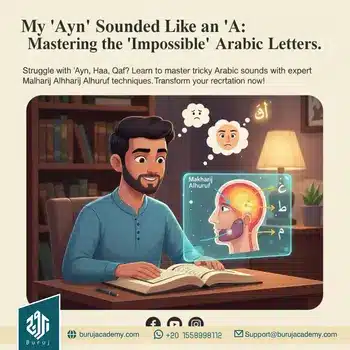My ‘Ayn’ Sounded Like an ‘A’: An Inside Look at Mastering the ‘Impossible’ Arabic Letters – Makharij Alhuruf
The journey to learn the Arabic language, especially for non-native speakers, is filled with moments of wonder, enlightenment, and, let’s be honest, a fair share of tongue-twisting challenges. For me, the aspiration was always clear: to recite the Quran with beauty and precision, just as it was revealed. However, a significant hurdle quickly emerged, one that many students of Arabic, particularly those focused on Quranic recitation, will instantly recognize: mastering the unique and often elusive sounds known as Makharij Alhuruf. Specifically, I struggled immensely with letters like ‘Ayn (ع), Haa (ح), and Qaf (ق). My ‘Ayn sounded frustratingly like a plain ‘A’, my ‘Haa’ was indistinguishable from a regular ‘H’, and ‘Qaf’ felt like a constant battle between my throat and my tongue. It felt like I simply couldn’t make the sounds, no matter how hard I tried. This is the story of how I faced these ‘impossible’ Arabic letters head-on and, with persistence and the right guidance, finally conquered them.
The Initial Frustration: A Lingering Linguistic Lull
From the outset, I understood the importance of Makharij Alhuruf – the points of articulation of the Arabic letters. I knew that proper pronunciation wasn’t merely an aesthetic choice; it was fundamental to preserving the meaning of the Quran. A slight mispronunciation can dramatically alter a word’s sense, and that realization weighed heavily on me. I wanted to honor the Quran with my recitation, not inadvertently distort its message.
Contact Us For More Details
My early attempts were disheartening. I’d sit for hours, repeating words, trying to mimic the sounds I heard from my teachers or audio recordings. For simpler letters, I saw gradual improvement. But when it came to the throat letters, particularly ‘Ayn, ‘Haa’, and the deep-seated ‘Qaf’, I hit a wall.
I remember my first Quran recitation class. The teacher would say, “Say ‘Alhamdulillah’ (الحمد لله),” and I would confidently utter something that sounded more like “Alhamdu lillah.” She would gently correct me, pointing out the need for a stronger ‘Haa’. I’d try again, straining my throat, feeling like I was gagging, and still, it wouldn’t come out right. The ‘Ayn’ in “A’udhu” (أعوذ) was another nightmare. It would simply vanish or morph into an ‘A’, completely missing the distinct guttural quality. And ‘Qaf’? That was a beast. It would always sound like a ‘Kaf’ (ك), a lighter sound from further forward in the mouth, rather than the robust, emphatic ‘Qaf’ from the back of the tongue.
It wasn’t just my teacher who noticed. I could hear the difference myself, which amplified my frustration. There were moments when I felt truly discouraged, wondering if my vocal cords were simply not wired for these particular Arabic sounds.
Understanding the Anatomy of Sound: The Science of Makharij Alhuruf
My breakthrough began when I shifted my approach from mere mimicry to a deeper understanding of the mechanics of Makharij Alhuruf. My new tutor, a specialist in Tajweed (the rules of Quranic recitation), didn’t just tell me to “make the sound”; she explained how the sound is made. She emphasized that each letter has a specific articulation point and method of airflow.
She drew diagrams, used anatomical models, and even had me place my fingers on various parts of my throat and tongue to feel the movements. For instance:
- ‘Ayn (ع): This sound comes from the middle of the throat, and it requires a slight constriction, not a full closure. It’s often described as the sound a goat makes or like trying to swallow something slightly too big. The key was learning to engage the correct muscles without tensing up completely.
- ‘Haa (ح): Also from the middle of the throat, but unlike ‘Ayn’, it’s an expelled, breathy sound, almost like sighing with effort. It’s not a soft ‘H’ as in “hat,” but a more forceful, whispered expulsion from the throat.
- ‘Qaf (ق): This is the emphasized ‘K’ sound, originating from the very back of the tongue hitting the soft palate (the fleshy part at the back of the roof of your mouth). It’s a deep, powerful sound, distinct from the lighter ‘Kaf’.
This detailed, scientific approach to Makharij Alhuruf was revolutionary. It demystified the process. It wasn’t about some innate talent I lacked; it was about learning to control specific muscles and airflows in my vocal apparatus.
Check out Buruj Academy’s Tajweed courses today!
Targeted Drills and Patient Practice: The Road to Mastery
With a newfound understanding, I embarked on a rigorous practice regimen focused specifically on the problematic letters. My tutor designed targeted drills, often isolating the difficult sounds.
For ‘Ayn’, we would start by trying to feel the vibration in the middle of my throat. She would have me make a soft “ah” sound and then try to subtly constrict, focusing on the muscle engagement. We practiced saying “A-A-A-Ayn” over and over, slowly trying to produce the distinct sound. We used words that began with ‘Ayn’, like “A’udhu” (أعوذ), “Alim” (عليم – knower), and “Amal” (عمل – work), breaking them down syllable by syllable.
For ‘Haa’, the focus was on the forceful, expelled breath. We practiced exhaling sharply with my hand on my throat to feel the distinct vibration and airflow. She encouraged me to imagine fogging up a mirror with my breath, but from the throat. We worked on words like “Rahman” (رحمن – Most Merciful), “Hamd” (حمد – praise), and “Sahih” (صحيح – correct), emphasizing the strong ‘Haa’.
And for ‘Qaf’, it was all about tongue placement. I would often accidentally bring my tongue forward. She had me practice with a mirror, making sure the back of my tongue was indeed touching the soft palate. We’d practice “Q-Q-Qaf,” and then move to words like “Qul” (قل – Say!), “Qamar” (قمر – moon), and “Qalam” (قلم – pen). The distinction between ‘Qaf’ and ‘Kaf’ was particularly important, and she would have me alternate between them to highlight the difference in articulation.
These drills were intense, often lasting for 15-20 minutes focused solely on these sounds before moving on to full words or Quranic verses. There were still moments of frustration, but now I had a clear roadmap, and I could feel subtle improvements.
The Breakthrough Moment: From Frustration to Fluidity
The breakthrough didn’t happen overnight, but it was gradual and incredibly rewarding. I remember the exact moment my ‘Ayn’ finally clicked. I was practicing “A’udhu billahi minash-shaytanir-rajim,” and for the first time, I felt the correct constriction, the distinct guttural quality of the ‘Ayn’. It wasn’t perfect, but it was undeniably there. My teacher beamed, “Mashallah! You got it!” That validation was immense.
Similarly, my ‘Haa’ became stronger and clearer, no longer sounding like a soft whisper. The most satisfying improvement, however, was with ‘Qaf’. The emphatic, deep sound finally emerged, giving my recitation a richness and accuracy I had longed for. I could finally differentiate between words like “Qalb” (قلب – heart) and “Kalb” (كلب – dog) – a crucial distinction!
Mastering Makharij Alhuruf transformed my entire approach to Quranic recitation. It wasn’t just about making the sounds; it was about internalizing them, allowing them to flow naturally without conscious effort. This newfound ability brought immense confidence and joy to my worship.
Why Mastering Makharij Alhuruf is Non-Negotiable
For anyone serious about learning Arabic or reciting the Quran, prioritizing Makharij Alhuruf is essential. Here’s why:
- Preservation of Meaning: As mentioned, incorrect pronunciation can change the meaning of words, which is critical when dealing with the divine speech of Allah.
- Beauty and Fluency: Correct pronunciation enhances the aesthetic beauty of recitation, making it more melodious and impactful.
- Tajweed Foundation: Proper Makharij is a cornerstone of Tajweed rules. Without it, other rules like Qalqalah or Idgham cannot be applied correctly.
- Confidence: Overcoming these linguistic challenges builds immense confidence in one’s ability to learn and master the language.
- Spiritual Connection: Reciting the Quran correctly deepens one’s spiritual connection to its message.
My Advice to You: Conquer the ‘Impossible’
If you’re currently struggling with ‘Ayn, ‘Haa’, ‘Qaf’, or any other challenging Arabic sounds, here’s my advice:
- Seek Qualified Guidance: A skilled Tajweed teacher who can patiently explain the mechanics of each letter is invaluable.
- Understand the Anatomy: Don’t just try to copy. Ask your teacher to explain how the sound is made anatomically.
- Isolate and Drill: Practice each difficult letter in isolation, then in short words, then in verses. Repetition is key.
- Record Yourself: Listen back to your recitation. This helps you identify errors and track progress.
- Be Patient and Persistent: Mastering Makharij Alhuruf takes time and consistent effort. Don’t get discouraged by slow progress. Every small improvement is a step forward.
- Listen Actively: Listen carefully to expert reciters, paying close attention to how they articulate the challenging letters.
My journey from “My ‘Ayn’ Sounded Like an ‘A'” to confidently articulating the unique sounds of the Arabic alphabet has been one of the most rewarding aspects of my Arabic learning experience. It taught me that with the right guidance, a strategic approach, and unwavering persistence, no sound is truly ‘impossible’. Embrace the challenge, and you too will unlock the beauty and precision of the Arabic language.
Connect with Our Community – Makharij Alhuruf
High-value education extends beyond the classroom. We provide free resources and a supportive community to help you on your journey. For free tips, student stories, and academy updates, follow us on Facebook, watch our educational lessons on YouTube, and join the conversation on Instagram.




